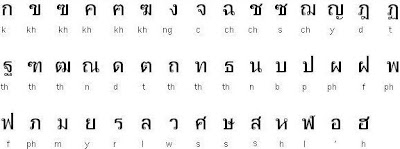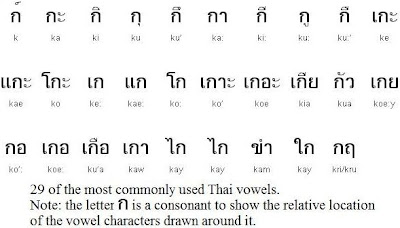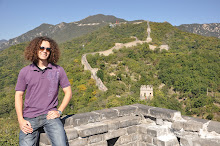As of this writing I have completed 3 series of Thai language classes and I am currently taking the 4th. Each class consists of twenty 3-hour days with homework and tests. The first and second class emphasize proper phonetics so that basic conversation skills are learned. The higher level classes teach the Thai alphabet, reading, writing, and various subjects of Thai culture. I am still amazed at the complexity of the Thai alphabet and writing system, yet at the simplicity of speaking. Here are some interesting points I have learned about the Thai language so far.
TonesInitially, the most difficult aspect of the Thai language is to learn are the 5 different tones a word can have. The English language is non-tonal, therefore, most words have only one way to be pronounced. However, a Thai word can have 5 different ways of pronunciation, or tones - each with a different meaning. At first, all 5 tones sounded the same to me! However, with good teaching and practice your brain will learn to distinguish the subtle differences. One must be careful when listening and speaking Thai so that the intended meaning of the word is understood.
The five tones are:Mid - the word has a neutral, flat pitch. All English is mid toned.
Low - pitch of the word goes down. Imagine a word that is trailing off…
Falling - pitch of the word goes up, then down. Think Doppler Effect - the sound of a train horn going up then down as it passes by.
High - pitch of the word goes up. Similar to the upward inflection when asking a question.
Rising - pitch of the word goes down, then up. The word has a dip to it.
For example, the Thai word “na” has 5 different meanings depending on the pitch and inflection used when speaking the word, as shown below.

A common Thai tongue-twister sayng the word ‘mai’ 4 times in a row (but with slightly different tones)
IPA - mai mài mâi mái
Thai - ไหมใหม่ไหม้มั้ย
English - “Does new silk burn?”
Check out this website for audio clips of the different Thai tones.
http://www.learningthai.com/tones/index.html Thai soundsAnother interesting aspect of speaking Thai was learning how to pronounce new sounds. The most difficult new sound for me to learn was “ng”. English words such as ‘wing’, ‘long’, and ‘singer’ all have ‘ng’ sound at the end or middle of the word. No problem there. The hard part is starting a word with ’ng’. Instead of saying “singer”, remove the ‘si’ and try to only pronounce “nger”. Be sure not to pronounce it as “ner” or “ger”, the word must start with the ‘ng’ sound (and no cheating by putting a vowel in front). The trick is to use the back of your tongue to touch the roof of your mouth. Once you’ve mastered that, try out the 5 different tones with it.
A couple of other new sounds were ‘uh’ as in saying “uh-huh” or "about", and ’eu’ which is similar to ’uh’ but with more of a deeper, strained, grunting sound (reminds me of that Master P song, ‘make you say ‘uuhhhh’, nuh-nah na-naah).
The Thai alphabet - อักษรไทยThere are 44 consonants representing 21 distinct consonant sounds and 32 vowels. Similar to English, each Thai letter represents a sound. Thus, once you learn the sounds of each consonant and vowel you can begin sounding out words.
Thai Consonants

If you look closely at the consonant table above the you’ll notice that there are multiple Thai consonants having the same English letter equivalent. For example, the letter “T” in English represents one unique sound. However, there are 6 Thai letters that represent the same “T” sound. Even though the 6 Thai letters sound the same, they are uniquely written and fall into one of the 3 different classes of Thai letters. These different classes of letters determine the tone of the following vowel which gives the word it’s specific meaning.
Thai Vowels

As shown above, an interesting aspect of written Thai is that vowel symbols can be written above, below, before, or after a consonant, and some vowels are a combination of 2 or more symbols! Additionally, there are five tone marks that can be written above a letter. Thus, it is no uncommon for a Thai word to have a tone mark written above a vowel which is written above a consonant. Fun stuff! Finally, there are the many exceptions to the already confusing rules and the special cases that aren’t worth mentioning now.
The actual writing of the Thai characters isn’t that bad at all. The characters are fairly simple to draw. The difficult part was memorizing how to sound out and write the ridiculous amount of letters (66 total). It took about 2 weeks of class to memorize how to write the 44 consonants and half the vowels, and another 2 weeks for the remaining vowels.
Grammar and Sentence StructureNow comes the easy part. The Thai grammar and sentence structure is so easy that once you learn a few words you can easily formulate sentences and actually communicate without sounding like an idiot. Here are a few of my observations.
- There is no formal punctuation used in Thai. Brackets, quotation marks and exclamation marks can be used in the same way as in English. Commas and periods are rarely seen.
-Written Thai words are not separated from each other and the letters generally flow uninterrupted until the idea changes. If you look at the newspaper or a book, it just looks like a bunch of long strings of Thai letters.
ผมพูดภาษาไทยได้นิดหน่อย - "I can speak a little Thai"- The verb “to be” is not spoken. English words such as ‘the‘, ‘am‘, ‘are‘, and ‘is’ are implied.
English The man is at the bathroom
Thaiman at bathroom
EnglishWhere are your shoes?
Thaiyour shoe where?
- Verbs are not conjugated. They do not change with person, tense, voice, mood, or number
EnglishI eat rice
ThaiI eat rice
EnglishThey drank beer
Thai
They drink beer already
EnglishHe stumbles to the bar
ThaiHe stumble to bar (now)
-Adjectives follow the word they modify
English
The glass of red wine
ThaiGlass wine red
EnglishThe red glass of white wine
Thaiglass red with wine white
English
The woman with long hair
Thai
Woman have hair long
English
The food was delicious
Thai
Food delicious already
-Although there is a Thai word for “very”, emphasis can be created by simply repeating the adjective
English
A fat dog
ThaiDog fat
EnglishThis dog is very fat
Thai
This dog fat fat
This dog fat very
As in most countries, most Thai people appreciate and enjoy it when foreigners are able to speak a little bit of their language. On more than one occasion I have shocked and impressed a Thai person when I try to speak to them. One time I was getting my hair cut and the barber asked if I could speak Thai. I busted out with my 2 months worth of Thai learning and he was so blown away at how I could pronounce certain words that he said the hairs on his arms were raised! (he showed me too). I am a long way from speaking fluently, but I can get the gist of most conversations. I probably have the equivalent vocabulary and reading skills of a 3rd grader. All in all, learning the Thai language has been challenging and enjoyable. The speaking aspect is fun and not too difficult to get a hang of. The reading and writing is a bit more challenging and it seems to exercise a part of my brain that is rarely used. Now that I know most of the basic writing rules, the pieces are slowly falling into place. It has become less of a chore to read and write and more of a challenging game or puzzle. I would highly recommend a class in basic Thai conversation skills for anybody planning on living in Thailand for an extended period of time.



